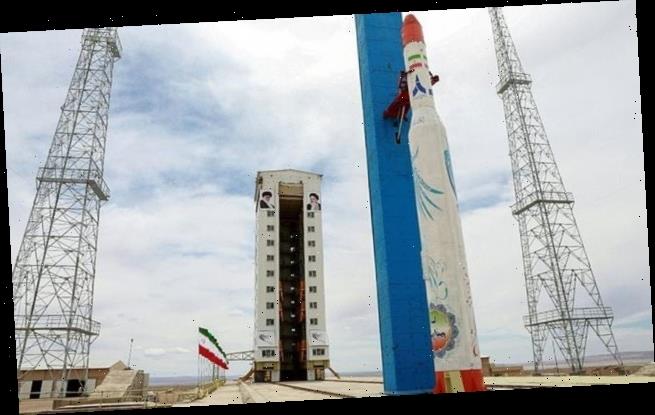Iran will launch new science satellite ‘within hours’ despite US fears Tehran will use rocket technology to enable nuclear missile strikes
- Iran announced it is scheduled to launch a scientific observation satellite today
- Telecommunications minister tweeted that the launch was ‘In the Name of God’
- US is concerned long-range ballistic rockets could also launch nuclear warheads
- Tehran denies satellite activity is a cover for missile or weapons development
Iran started counting down to the launch of a new scientific observation satellite today, the country’s telecommunications minister said.
The United States has raised concerns in the past about Iran’s satellite programme, describing the launch of a carrier rocket in January 2019 as a ‘provocation’.
Its ‘primary mission’ would be collecting imagery, Morteza Berari said, adding that Iran needed such data to study earthquakes, deal with natural disasters and develop its agriculture.
Once the satellite is in orbit, the first picture that it will transmit will be of Iranian military commander Qassem Soleimani, who was killed in a US drone strike in Baghdad last month, minister Mohammad Javad Azari Jahromi said today.
‘Beginning countdown to launch #Zafar_Satellite in the next few hours… In the Name of God,’ Azari-Jahromi wrote on Twitter.
On February 1, the head of Iran’s space agency said the 113-kilogramme Zafar – which means Victory in Farsi – would be launched into orbit 329 miles above Earth by a Simorgh rocket.
A Simorgh (Phoenix) satellite rocket at its launch site at an undisclosed location in Iran (file image). The country’s telecommunications minister announced the launch of a scientific satellite today on Twitter
Iranian Quds Force commander Qassem Soleimani in 2016. The first picture the Iranian satellite will transmit will be of the Iranian military commander, who was killed in a US drone strike in Baghdad last month
Tensions between Iran and the United States, already high over the nuclear issue, reached the highest level in decades after Soleimani was killed. Iran retaliated with a missile attack against two US bases in Iraq.
In January 2019, Tehran announced that its Payam – Message in Farsi – satellite had failed to reach orbit, after authorities said they launched it to collect data on the environment in Iran.
The US said the launch of the carrier rocket was a violation of a 2015 UN Security Council resolution which endorsed an international accord on curbing Tehran’s nuclear programme.
The United States says it is concerned that long-range ballistic technology used to put satellites into orbit could also be used to launch nuclear warheads.
Tehran denies that satellite activity is a cover for missile development and says it has never pursued the development of nuclear weapons.
President Donald Trump’s administration reimposed sanctions on Iran following Washington’s 2018 withdrawal from an international accord designed to curb Iran’s nuclear programme.
Trump said the nuclear deal did not go far enough and did not include restrictions on Tehran’s missile programme.
A satellite image of a failed Iranian rocket launch at the Imam Khomeini Space Center in Semnan, Iran, last August
Resolution 2231 called on Iran to refrain from any activity related to ballistic missiles capable of delivering nuclear weapons.
Iran maintains it has no intention of acquiring nuclear weapons, and says its aerospace activities are peaceful and do not violate the security council resolution.
Tehran confirmed in September that an explosion occurred at one of its satellite launch pads due to a technical fault, and slammed Trump for ‘gleefully’ tweeting about it.
Replying to a tweet that asked what if Zafar fails like it predecessor, Jahromi said ‘we will try again’.
Iran’s internet services have faced cyber attacks for the past two days, according to the ministry. Officials have not elaborated on the source of the attack or its likely motives.
Iran launched its first satellite Omid (Hope) in 2009 and the Rasad (Observation) satellite was sent into orbit in June 2011.
Tehran said in 2012 that it had successfully put its third domestically-made satellite Navid (Promise) into orbit.
Source: Read Full Article



